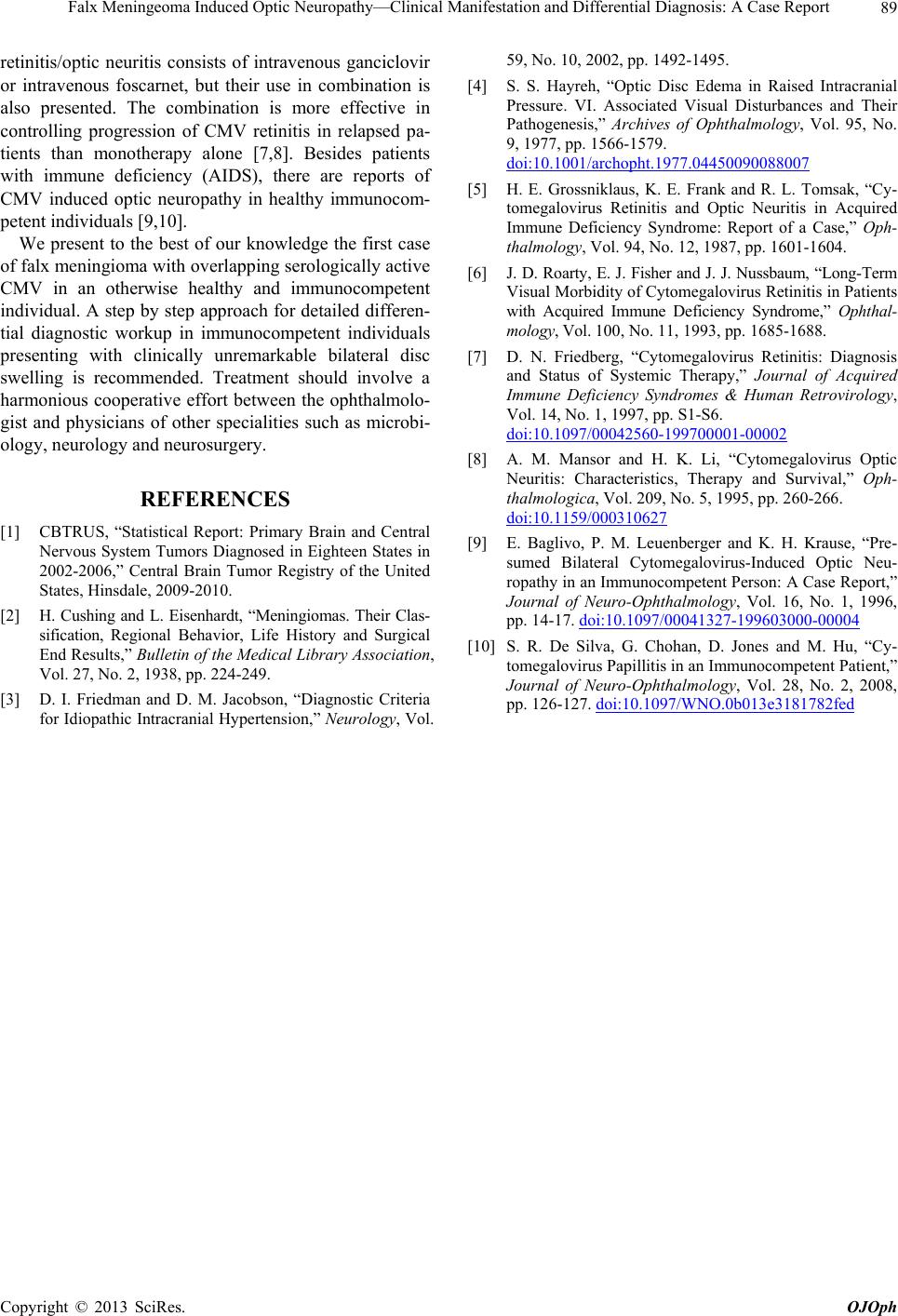
Falx Meningeoma Induced Optic Neuropathy—Clinical Manifestation and Differential Diagnosis: A Case Report
Copyright © 2013 SciRes. OJOph
89
retinitis/optic neuritis consists of intravenous ganciclovir
or intravenous foscarnet, but their use in combination is
also presented. The combination is more effective in
controlling progression of CMV retinitis in relapsed pa-
tients than monotherapy alone [7,8]. Besides patients
with immune deficiency (AIDS), there are reports of
CMV induced optic neuropathy in healthy immunocom-
petent individuals [9,10].
We present to the best of our knowledge the first case
of falx meningioma with overlapping serologically active
CMV in an otherwise healthy and immunocompetent
individual. A step by step approach for detailed differen-
tial diagnostic workup in immunocompetent individuals
presenting with clinically unremarkable bilateral disc
swelling is recommended. Treatment should involve a
harmonious cooperative effort between the ophthalmolo-
gist and physicians of other specialities such as microbi-
ology, neurology and neurosurgery.
REFERENCES
[1] CBTRUS, “Statistical Report: Primary Brain and Central
Nervous System Tumors Diagnosed in Eighteen States in
2002-2006,” Central Brain Tumor Registry of the United
States, Hinsdale, 2009-2010.
[2] H. Cushing and L. Eisenhardt, “Meningiomas. Their Clas-
sification, Regional Behavior, Life History and Surgical
End Results,” Bulletin of the Medical Library Association,
Vol. 27, No. 2, 1938, pp. 224-249.
[3] D. I. Friedman and D. M. Jacobson, “Diagnostic Criteria
for Idiopathic Intracranial Hypertension,” Neurology, Vol.
59, No. 10, 2002, pp. 1492-1495.
[4] S. S. Hayreh, “Optic Disc Edema in Raised Intracranial
Pressure. VI. Associated Visual Disturbances and Their
Pathogenesis,” Archives of Ophthalmology, Vol. 95, No.
9, 1977, pp. 1566-1579.
doi:10.1001/archopht.1977.04450090088007
[5] H. E. Grossniklaus, K. E. Frank and R. L. Tomsak, “Cy-
tomegalovirus Retinitis and Optic Neuritis in Acquired
Immune Deficiency Syndrome: Report of a Case,” Oph-
thalmology, Vol. 94, No. 12, 1987, pp. 1601-1604.
[6] J. D. Roarty, E. J. Fisher and J. J. Nussbaum, “Long-Term
Visual Morbidity of Cytomegalovirus Retinitis in Patients
with Acquired Immune Deficiency Syndrome,” Ophthal-
mology, Vol. 100, No. 11, 1993, pp. 1685-1688.
[7] D. N. Friedberg, “Cytomegalovirus Retinitis: Diagnosis
and Status of Systemic Therapy,” Journal of Acquired
Immune Deficiency Syndromes & Human Retrovirology,
Vol. 14, No. 1, 1997, pp. S1-S6.
doi:10.1097/00042560-199700001-00002
[8] A. M. Mansor and H. K. Li, “Cytomegalovirus Optic
Neuritis: Characteristics, Therapy and Survival,” Oph-
thalmologica, Vol. 209, No. 5, 1995, pp. 260-266.
doi:10.1159/000310627
[9] E. Baglivo, P. M. Leuenberger and K. H. Krause, “Pre-
sumed Bilateral Cytomegalovirus-Induced Optic Neu-
ropathy in an Immunocompetent Person: A Case Report,”
Journal of Neuro-Ophthalmology, Vol. 16, No. 1, 1996,
pp. 14-17. doi:10.1097/00041327-199603000-00004
[10] S. R. De Silva, G. Chohan, D. Jones and M. Hu, “Cy-
tomegalovirus Papillitis in an Immunocompetent Patient,”
Journal of Neuro-Ophthalmology, Vol. 28, No. 2, 2008,
pp. 126-127. doi:10.1097/WNO.0b013e3181782fed